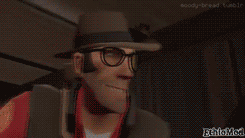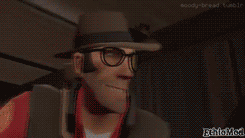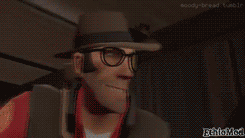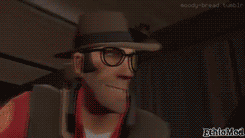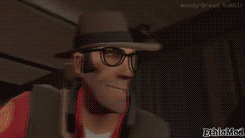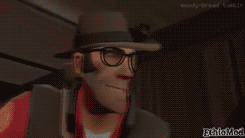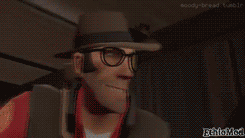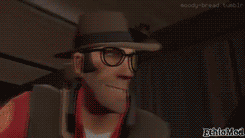Forgot To Post This Because I Was Waiting On The Desktop Background That Never Advanced Beyond A Sketch.
Forgot to post this because I was waiting on the desktop background that never advanced beyond a sketch.
dragon :)

More Posts from Peridots-pixiwolf and Others

[Start ID. A brown-toned comic of P3RI, the artist's botsona. They lament on how long it's been since they've played Dishonored, start playing it again, and then lie to itself that it'll keep this playthrough casual. The bottom quarter of the image lists the self-imposed challenges they rack up. End ID]
back at it again folks

[Start ID. The ending screen of the ULTRAKILL level P-2: Wait of the World. It was completed on Standard with a D rank, with 43 minutes and 47.094 seconds in time, 3020 style, and 59 restarts and kills both. The ranking board is blacked out so OP's steam username isn't shown, and on the other side of the screen the stats are unusually absent, indicating this is OP's first time beating the level. End ID]
sorry for showing up to liveblog ultrakill and then abandoning tumblr for five days in a row. It will happen again
For whatever number of you actually pay close attention to my nonsense posts I think I’ve officially decided to make an effort to Reblog Things. I’ll still have my art tag (peridots-art) along with hopefully soon adding a reblogs tag (peridots-reblogs), so if you’re here purely for the art posts you can just block the latter or solely scroll through the former
Gave my somewhat-old Hollow Knight OCs a new ref

Since all the text on that is annoying to list in alt text, or if my handwriting is too hard to read, here it is below instead (paraphrased/edited a bit):
To the right of Hawksbeard reads “Hawksbeard, he/him, Grasshopper, Mosskin”, text to the right of Molini is “Molini, she/her, Millipede”, and to the left of Caramel reads “Caramel, she/her, Carpenter Bee”. Hawksbeard’s section notes that both his fluff and mask are removable though he never takes off his mask, he can jump absurdly high (around eight times his height), he always spends his time alone by experimenting, recording, or collecting, and he lives in Kingdom’s Edge. Molini’s section notes that her face is in fact an actual face and not a mask, her eyes glow, she lost the left arm on her third non-head segment down, and she lives in the Ancient Basin. Caramel’s section notes that her wings are frayed, she can take her mask off but also usually doesn’t, she earned the mantis claw from a Traitor Hunt with her sisters and has been fighting with it since, and she lives in the Queen’s Gardens.
oh boy I am memorizing Too Many Species Right Now!! Most of them are because I have bug characters
Here is all of the information I can gather directly from my mind right now:
(mentions of lots of arthropods and a cnidarian under the readmore!)
Sphecius convallis - the pacific cicada killer wasp, closely related to but not to be confused with the more well-known eastern cicada killer, in the same genus with the species name speciosus. It's a tannish-orange color with yellow and off white markings, primarily on its face and abdomen.
Parides montezuma - Montezuma's cattleheart, a black butterfly with bright red markings on the tips of its forewings and on its abdomen, grayish stripes also marking the latter.
Dynastes tityus - the eastern hercules beetle, one of the horned beetles in a dull greenish-yellow, with black freckles on the elytra, as well as a black elytral/prothoracal "margin", prothoracal horn and head. It has tan fur on the undersides of said horn, as well as thorax and abdomen. As with most (all?) horned beetles the horn is only present in males.
Apis mellifera - way too prevalent for me to forget ever, the western/european honeybee. This is the bee that is normally and widely domesticated for honey. It has a light brown head and thorax and (in workers) a yellowish and dark brown banded abdomen, and is one of the rare social species of bees. While western honeybee numbers are in fact decreasing, they aren't close to extinction and are competing with native bees, who ARE indeed endangered.
Polistes olivaceus - commonly referred to as the yellow paper wasp, yellow oriental paper wasp or Macao paper wasp. Yellow, with thin and numerous tan, brown or black bands all along its body.
Sphex pensylvanicus - the great black wasp, or great black digger wasp. It's pretty notable for being all-black with metallic, dark blue wings, and was probably first examined in Pensylvania, U.S. considering the species name but can be found in several places that are Not There in the country. I found a dead one on the side of the road and I put her in my house
Tachypompilus ferrugineus - The rusty spider wasp. It's one that preys on spiders (several? only one?), dragging it (them?) back to her nest to lay eggs on. I've already nerded out about this for a reason, because seeing a red wasp with metallic blue wings drag a wolf spider 2x her size across your front lawn into a hole of unknown depth is a memorable experience.
Polydrusus impressifrons - A weevil. It's sort of pale lime green, sparkling with yellows and darker greens in the elytra chitin, which notably to me is not smooth but rather has straight thin "valley"s carved through it from end to end? I'm sure there's a better word for it but I can't currently remember.
Pleurobrachia pileus - A jellyfish called a sea gooseberry along with the other member of its genus. ...It looks like a drop of water.
Myrmecocystus mexicanus - An ant in one of the genuses holding those known as honeypot ants, but it's not really said if the species itself is in fact one with modified honeypot workers, so I assume it probably isn't? Workers are a light golden-tan, with the head being a bit darker.
Cranjon cranjon - It's a thin light brown shrimp, that iirc is often caught for food. I just think the name is cool
Vespula maculifrons/germanica/vulgaris - three very similar-looking species of yellowjacket in the same genus, the former called the eastern yellowjacket and both the latter called european yellowjackets, though germanica is also called the german wasp while vulgaris is called the common wasp. They're basically what the average person thinks of when hearing the word wasp, with striking bands of black and yellow. They construct papery nests despite not being part of Polistes, and I can't exactly remember their differences currently? There's a tree in my area they were all swarming around about a week ago and I fed them italian ice before one was carried away and eaten mid-flight by a larger bald-faced hornet. Fun times.
I can't remember the scientific name of this one, but it is most commonly referred to as Avispa de caballo (Horse's wasp, not to be confused with horse guard wasp) and it bears close resemblance to cicada killers, due to them both being sand wasps.
Megaloblatta longipennis - one of, if not, the largest species of cockroach. I don't know why I remember this?
Lampyris noctiluca - a species of lampyrid beetle, of which is otherwise known as a firefly or lightning bug, or a glowworm for the larvae and the larviform adult females. The species is one of the most commonly seen fireflies, I believe?
Coenagrion puella - a damselfly species. The male imagos are blue, while the females are green or brown, and both have black abdominal bands and thoracic stripes. It's one of the species that folds its forelegs up near its head.
Strategus aloeus - the ox beetle. It's chestnut brown, with the males having one long forward-facing prothoracic horn and two smaller ones facing back. It doesn't have haired elytra like Pygopleurus, but the underside sure is fluffy!
And that's not even counting all the times I nerded out while writing this, like about how cockroaches are actually most related to termites and that taxon is the sister group of mantises, or how brush-footed butterflies (including monarchs!) do the same thing (as puella) with their reduced forelegs tucked up behind their head so they stand on fours, or how odonates have such large eyes and great vision that they catch their prey 90% of the time, being the most successful hunters, and can predict said prey's movement. Or counting the many nudibranchs I remember the appearances, but not the names, of in vivid detail
Anyway. Uh. Writing this felt way shorter than the time it took. Goodbye
-
 program-251 liked this · 2 years ago
program-251 liked this · 2 years ago -
 vampireopossum liked this · 2 years ago
vampireopossum liked this · 2 years ago -
 original-character-chaos liked this · 2 years ago
original-character-chaos liked this · 2 years ago -
 do-not-put-anything-here liked this · 2 years ago
do-not-put-anything-here liked this · 2 years ago -
 little-red-rabbit liked this · 2 years ago
little-red-rabbit liked this · 2 years ago -
 granitethesandwing reblogged this · 2 years ago
granitethesandwing reblogged this · 2 years ago -
 granitethesandwing liked this · 2 years ago
granitethesandwing liked this · 2 years ago -
 phela liked this · 2 years ago
phela liked this · 2 years ago -
 epochthedragon reblogged this · 2 years ago
epochthedragon reblogged this · 2 years ago -
 jaxthekat liked this · 2 years ago
jaxthekat liked this · 2 years ago -
 who-is-this-weirdo reblogged this · 2 years ago
who-is-this-weirdo reblogged this · 2 years ago -
 who-is-this-weirdo liked this · 2 years ago
who-is-this-weirdo liked this · 2 years ago -
 ameliejoyart reblogged this · 2 years ago
ameliejoyart reblogged this · 2 years ago -
 ameliejoyart liked this · 2 years ago
ameliejoyart liked this · 2 years ago -
 skykid-nadir liked this · 2 years ago
skykid-nadir liked this · 2 years ago -
 stars-etc liked this · 2 years ago
stars-etc liked this · 2 years ago -
 luciaslullaby liked this · 2 years ago
luciaslullaby liked this · 2 years ago -
 peridots-pixiwolf reblogged this · 2 years ago
peridots-pixiwolf reblogged this · 2 years ago

Heya, I'm Peridots, your average digital artist/entomology enthusiast—they/it/he or any pronouns, please! Haven't actually posted much art in quite a while, so be prepared for occasional Bug Facts and other such randomness. Spam likes and such are all appreciated here! Terfs, zionists and the like can turn 180° for free, however! Profile art by original-character-chaos—oooooh looks like someone sent me perfectly pfp-shaped gift art of my sona a little too close to april fools!
434 posts


